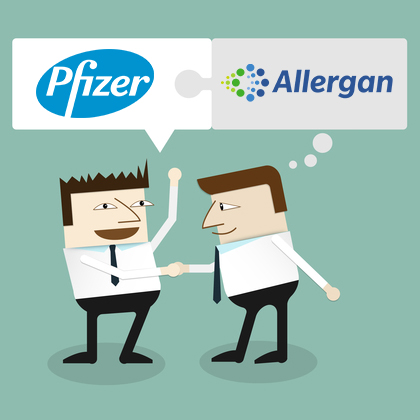On Monday, November 23, 2015, while many were working a short work week due to the Thanksgiving holiday in the United States, Pfizer and Allergan management were busy announcing a merger that will create the world’s largest pharmaceutical company valued at $160 billion. On the surface, analysts and politicians focused on the tax inversion created by this deal because Allergan (the smaller of the two companies) is acquiring the larger Pfizer. The reason is that Allergan (formerly of Irvine, CA) is headquartered in Dublin, Ireland, where corporate tax rates are lower than they are in the United States, where Pfizer is based. Once approved, this will mean corporate taxes for the new company (to be called Pfizer) will drop from a rate of 25% to 17%-18%.
The deal with Allergan comes after Pfizer attempted a hostile takeover of rival pharmaceutical company, AstraZeneca, based in London, England, in 2014, which was refused by AstraZeneca and frowned upon by British regulators. Tax inversion is not a new phenomenon, and the re-domiciling of corporate headquarters to places like Bermuda and Ireland have happened in many industries, not just in pharmaceuticals.
The real need for Pfizer to merge with another company stems from its recent performance and mature product portfolio. Pfizer has experienced patent expirations of many of its blockbuster medications that were once stellar growth drivers, including Lipitor cholesterol-lowering medication and Celebrex arthritis medication. Wall Street has pressured Pfizer to reinvigorate its growth as revenues have declined for five straight years from a peak of $67.8 billion in 2010 to expected sales of $48 billion in 2015. An acquisition that would improve short-term profitability and buy Pfizer time needed to grow some of its promising new medications into the next crop of blockbusters was urgently needed.
When comparing the two product portfolios of Allergan and Pfizer, they are very different with little overlap. Allergan’s main areas of focus are dermatology, esthetics, eye care, CNS, cardiovascular, and women’s health medications. Allergan recently merged with Actavis, which broadens the company’s appeal with capabilities in both branded and generic drugs. Allergan offers a wide array of medications that are mostly patent protected, delivering more revenues and profits. Pfizer’s portfolio focuses on oncology, inflammation, vaccines, and immunology. The disparity in portfolios may help speed up regulatory approvals for the deal in the short term, but also eases the financial pressure and buys time for Pfizer to focus on building its newer medications, such as Ibrance for breast cancer, Enbrel for rheumatoid arthritis, and Avelumab for cancer immunotherapy.
Both Allergan and Pfizer also sell nonprescription medications and consumer products. Pfizer’s OTC portfolio is full of mature brands, such as Advil, Robitussin, Dimetapp, and ChapStick, which are analyzed in our Nonprescription Drugs USA report. The addition of Allergan’s eye care brand Refresh and professional skin care brand SkinMedica to Pfizer’s Consumer Healthcare portfolio will add depth and invigorate profitability. An assessment of Pfizer’s new consumer health business and line item profitability for its leading OTC product classes will be assessed in our upcoming OTC Drugs: U.S. Competitor Cost Structures study. Furthermore, after Pfizer’s discontinuation of the Rx-to-OTC switch application for Lipitor in July 2015, the merger with Allergan creates possible opportunities to help fill that void with other switch candidates in more straightforward categories, such as acne and eye care. Future switch candidates for Allergan and Pfizer are analyzed and forecast in our Rx-to-OTC Switch Pipelines USA: Competitive Assessment study, which was published in August 2015.
Through its brands M.D. Forté and Prevage MD, which were later replaced by the Vivite product range, Allergan has been a prominent player in the professional skin care market since the mid-2000s. In early 2013, the company acquired SkinMedica’s prescription and nonprescription skin care products, generally sold by doctors, for an upfront payment of $350 million. According to the latest published edition of our Professional Skin Care Global Series study, as of 2015, SkinMedica’s sales at the manufacturers’ level in the United States are estimated at over $86 million, growing at a healthy CAGR of about 18% since 2010. The brand also ranks in the top three in the medical care providers channels and has an active and growing online sales presence.
Recently, rumors circulated that Pfizer was considering spinning off its Global Established Pharmaceutical division that sells the company’s older medications in order to focus on its Global Innovative Pharmaceutical division. However, upon announcing the deal to merge with Allergan, Pfizer also announced that a decision for such a spinoff will be reserved until much later, likely 2018 or 2019. Brent Saunders, President and CEO of Actavis, has also been outspoken in his position that large pharmaceutical companies should spend less on R&D and drug discovery and should focus on drug approvals and marketing, leaving discovery and development to more nimble biotech and start-up pharmaceutical companies. That position is a direct contradiction to Pfizer’s business model historically, but could signal a paradigm shift for the new entity in the future.

